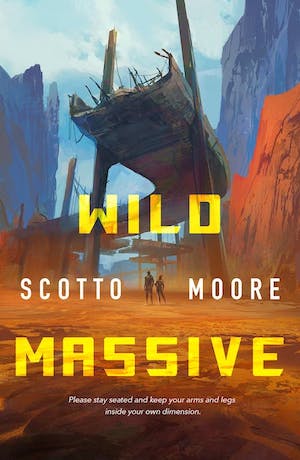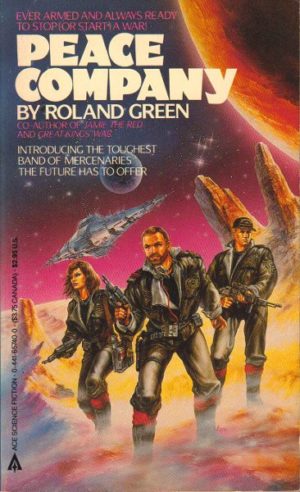In this bi-weekly series reviewing classic science fiction and fantasy books, Alan Brown looks at the front lines and frontiers of the field; books about soldiers and spacers, scientists and engineers, explorers and adventurers. Stories full of what Shakespeare used to refer to as “alarums and excursions”: battles, chases, clashes, and the stuff of excitement.
In the 1980s, there was a surge of interest in military science fiction, and the bookstore chains of the day—including Waldenbooks, Borders, and Barnes & Noble—were more than willing to fill their shelves with paperback originals to serve the market. That created an opportunity for a number of newer writers to make their mark. One of the most consistent and reliable of those authors was Roland J. Green, whose Peace Company (1985) is a fine example of the subgenre.
There were a number of big names whose work in the 1970s whetted the appetite of science fiction readers with an interest in military adventures, including Joe Haldeman, Jerry Pournelle, David Drake, and Gordon R. Dickson. In the 1980s, the increased focus on militarization during the Reagan administration bled into popular culture, leading to an increase in demand for science fiction adventures with military themes. Newer authors joined these big names in meeting this demand, sometimes co-writing books with established authors. There were also numerous military themed anthologies that appeared with the big-name authors listed as editors or co-editors. Roland J. Green first gained attention in the military SF arena when he co-authored the second and third books of Jerry Pournelle’s popular Janissaries series. Soon he was turning out military SF novels on his own, including Peace Company and Starship Shenandoah. He wrote new installments in the military fantasy Conan series. He was a solid contributor to what was known as “mid-list” fiction, books that sold modestly but consistently. His output dropped after 2000, probably because of changes in the publishing industry that hit mid-list authors the hardest.
About the Author
Roland J. Green (1944-2021) was an American science fiction and fantasy author whose work centered primarily on adventure and military matters. He held a bachelor’s degree in Political Science and a masters degree in International Politics. Most of his work was at novel length, but he did produce some short fiction, primarily for anthologies with military themes. He also co-edited several anthologies. He also co-authored several books, writing with Jerry Pournelle on his Janissaries series, with John F. Carr on a sequel to the H. Beam Piper classic Gunpowder God, and a few others. Green worked on a number of franchises, including Conan novels for Tor, and the Dragonlance series for TSR. He is the author of the Wandor fantasy series, the Starcruiser Shenandoah space navy series, and the Peace Company science fiction mercenary series, along with other novels.
Warfare and Mercenaries
War stories have been a part of literature as long as there has been literature. Military conflicts allow authors to put their characters in all manner of jeopardy, which always adds to the excitement in a narrative. Wartime settings tend to showcase both the worst vices and highest virtues of humanity, and military adventures have always had a place in science fiction, with speculation about future wars a constant theme. If you look back through reviews in this column you will find more than a few examples of the subgenre, including reviews of books by Heinlein, Haldeman, Pournelle, Drake, Piper, Stirling, and many others. The online Encyclopedia of Science Fiction has some interesting columns on the themes of Military SF, War, and Future War.
Buy the Book


Wild Massive
Mercenaries, or soldiers of fortune, are individuals or organized units who fight for pay, not for their own nation or for patriotic reasons. There has sometimes been an air of romanticism attached to the idea of those who fight for gain instead of glory, although that mystique is often not rooted in reality. In the period between the two World Wars, there was also a lot of interest in the French Foreign Legion, a special corps of the French Army which allowed international soldiers to enlist, and which fought primarily in French colonies around the world. The romantic idea of people getting a fresh start regardless of their past sins or history, and going off on adventures in the exotic locales where the Legion served, provide ripe fodder for pulp magazines like Argosy, Blue Book, and Adventure. And there were more than a few movies that picked up these themes as well, including Beau Geste (which was remade a number of times), Desert Hell, Desert Legion, Renegades, the more recent March or Die, and even comedies like The Flying Deuces (where Laurel and Hardy join the Legion) and Abbot and Costello in the Foreign Legion.
And in the latter decades of the 20th century, there was a renewed interest in foreign service and mercenary adventures. There was even a magazine targeted at those interested in mercenary life (or at least dreaming about it), Soldier of Fortune, a monthly U.S. periodical established in 1975 that ceased publication in 2016. Mercenaries became popular within military science fiction, as evidenced by Gordon Dickson’s Dorsai tales, Jerry Pournelle’s John Christian Falkenberg and Janissaries adventures, and David Drake’s Hammer’s Slammers series.
Ironically, while neither of the forces on the opposing sides of the conflict portrayed in Peace Company are mercenaries, the marketing department obviously thought it was an angle that could sell the book. On both front and back covers, the Peace Company is described as “The Toughest Band of Mercenaries the Future Has to Offer.”
Peace Company
The book opens with an attack on the fishing boat Celestine Auphan by a shadowy military force headed by the mysterious “Team Leader,” who works for the even more mysterious “Game Master,” who seeks to sow chaos within the human alliance that encompasses about seventy-five worlds. The only clues we have about this force are the deputy commander’s Japanese name, Hiko, and indications that all or most of its members worship the Hindu goddess Kali, avatar of power, war, destruction, and change.
The Celestine Auphan’s captain abandons ship while helmsman Paul Rebenc leads other crew members in trying to save her. The first time I read this book, I saw in the Acknowledgements that there was a reference to Canadian singer Stan Rogers and his classic song “The Mary Ellen Carter,” but didn’t think much of it at the time. I later learned the song in my local pub, however, and when I opened the book for this re-read, I realize how much of Peace Company’s plot revolves around a retelling of that song’s story of a crew salvaging a sunken fishing boat the owners had abandoned (here’s a link to the song, which is worth a listen, and another link to its lyrics).
We then meet the actual Peace Company—or more accurately, Company Group Fourteen, Seventh (New Frontier) Brigade, Peace Force—through the eyes of the main character, Sergeant Major John B. Parkes. He has served with the 14th previously, and while he knows a few people in the chain of command, he has a lot to learn about the unit’s current staff and capabilities. He meets a young and imperious naval liaison officer, Lieutenant Katherine Forbes-Brandon, and while he doesn’t admit it at first, is immediately smitten with her, and spends the rest of the book contemplating rules against officer/enlisted fraternization (while the subject of women serving in combat, even in fictional situations, was controversial in those days, Green embraced the idea of a fully integrated fighting force).
The unit is immediately put on alert for deployment to the planet Clovis, where the conflict that led to the sinking of the Celestine Auphan has drawn attention from the interstellar government. The planet, whose many place and personal names suggest Quebecois origins, has been somewhat backward since the “Collapse War of 2088,” and is split between competing factions, which on the main continent include the land-based Ranchers and the Fishermen of the Storm Coast. The 14th suspects that the Game Master is involved in this conflict—a safe assumption since the Team Leader’s force is supporting and supplying insurgents from the Rancher faction, as well as local organized crime factions. The 14th is loaded aboard the Peace Cruiser Ark Royal and sent off to stabilize the situation.
Rebenc and the other crewmembers of the Celestine Auphan are determined to raise the ship and claim ownership by rights of salvage. Yet they are encountering surprising resistance from local officials and business owners, whose loyalty (other than to profit) is questionable.
During the voyage to Clovis, Parkes continues to work on unit readiness (giving readers a chance to learn more about the Peace Force), and becomes even more impressed with Lieutenant Forbes-Brandon. When they reach the planet, a security breach causes the CO to order an immediate parachute drop of forces to secure key locations. The Peace Forcers link up with the crew of the Celestine Auphan, and decide that helping them raise the vessel will go a long way toward restoring the balance of power between Fishermen and Ranchers.
The rest of the book involves a series of clashes between the Peace Force, Rancher insurgents, criminal gangs, and the mysterious Team Leader’s unit. There are pitched battles, logistical challenges, reversals of fortune, betrayals, and heroic deaths. The action set pieces are realistic, well described and exciting to read. And, to prevent spoilers, that’s all I’ll say about the events that unfold. The mission on Clovis is brought to a satisfying conclusion, and enough loose ends are left hanging (including the growing Parkes/Forbes-Brandon relationship) to make the reader interested in reading future books (there were two: These Green Foreign Hills and The Mountain Walks).
Green was not a flashy writer, and his prose is workmanlike and direct. The book is written in the third person, with viewpoint changes throughout, but the narrative progresses in chronological order in a straightforward manner. Green did his homework in building a detailed universe and military organization, but while he paints that world clearly, he never slows the narrative down with unneeded exposition and minutia not necessary to the plot.
Final Thoughts
Roland J. Green was one of the most capable of the many authors who wrote military science fiction in the final decades of the 20th century. Not many of his books are still available online or in electronic format, but if you run across his books in a used bookstore, they are certainly worth a look. Those who appreciate realism in their science fiction will find much they like in his books.
And now I turn the floor over to you: If you’ve read Peace Company, or the other tales by Green, I’d love to hear from you. And I’m also interested in your thoughts on other military science fiction tales from this era that are worthy of another look.
Alan Brown has been a science fiction fan for over five decades, especially fiction that deals with science, military matters, exploration and adventure.










